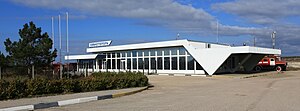Course of events
Former head of the rear food service of the Armed Forces of Ukraine, Colonel Oleksandr Kustanovych, during the occupation of Crimea by the Russian Federation in February – March 2014, served in the tactical aviation brigade of the Armed Forces of Ukraine near Belbek Airport. He later reported that on 27 February 2014, between 9 and 10 p.m., the officer on duty at the airport received a call from the commander of our unit. He said that the movement of unknown military personnel was noticed, and 12 military vehicles and 2 armored personnel carriers were found along the perimeter of the airfield behind the fence. On 28 February, food was delivered to these cars by cars with Russian license plates.
According to him, on 29 February, the Russian military seized the airport, and the Ukrainian military units stationed there were transferred to the administrative territory of the military town. A few days later, the Russian military carried out an assault on the unit using military equipment. The commander of the unit was with his personnel, after the capture of the unit, the commander was taken for negotiations, but he never returned.
During the blockade of the unit, the Ukrainian military was persuaded to defect to the Russian Federation. Subsequently, the Ukrainian military unit was independently redeployed to the mainland of Ukraine.
At the time of the assault, the unit had no more than 30-40 weapons, the rest were in warehouses. The Ukrainian military did not use weapons during the assault.
The fighters had only small arms, there were no traumatic weapons or stun grenades. Around the perimeter of the military town were high-rise buildings where the civilian population lived.
Kustanovych said that at the time of the assault, there were about 400 military personnel in the military town, and about the same number from the side of the stormtroopers. [3]
The Russian military, using stun grenades, captured almost all the buildings of the Ukrainian military unit 4515 in Belbek. First, the Russians occupied the building with the service hall for the delegations, the next day they occupied the premises with the airplanes, then surrounded the guards, demanding to surrender their weapons. After the refusal, they started throwing stun grenades. The fighters did not answer because they did not have the corresponding order. Next, Russian troops disarmed the Ukrainian soldiers. [4]
On 4 March 2014, it became known that the commander refused to hand over part of the military-technical aviation, and Colonel Yuliy Mamchur decided that part of the Ukrainians with weapons remained in the garrison, and part went to the airfield. [5]
Around 8:40 a.m., about 50 soldiers of the Ukrainian Armed Forces marched in a convoy to the airfield occupied by the Russians. When the convoy of journalists approached the entrance to the airfield, the Russians started shooting in the air, threatening to shoot the journalists in the legs.
The leader of the Russian soldiers spoke with Yuliy Mamchur. Mamchur demanded that the Ukrainian military be allowed to occupy their positions, and offered to jointly guard the warehouses on the territory of the airfield.
The Russians agreed in part, allowing a technical team, about ten people, to be partially brought to the position. [6]
On 22 March, the Russians began an assault on the military unit of the Armed Forces of Ukraine in Belbek, at 5:00 p.m., representatives of the Crimean Self-Defense Force and Russian soldiers broke into the territory. The gate to the unit was destroyed by an armored personnel carrier. [7]
Subsequently, the Russian military abducted Mamchur, and he did not contact him for several days. [8]

A military airfield in Belbek, a village near Sevastopol, Crimea, was also used for civil aviation, named Sevastopol International Airport Belbek, for six years from 2002 to 2007 under Ukrainian administration.
The annexation of Crimea by the Russian Federation took place in the aftermath of the 2014 Ukrainian revolution. On 22–23 February, Russian President Vladimir Putin convened an all-night meeting with security services chiefs to discuss pullout of deposed President, Viktor Yanukovych, and at the end of that meeting Putin remarked that "we must start working on returning Crimea to Russia.". Russia sent in soldiers on February 27, 2014. Crimea held a referendum. According to official Russian and Crimean sources 95% voted to reunite with Russia. The legitimacy of the referendum has been questioned by the international community on both legal and procedural grounds.

Yuliy Valeriyovych Mamchur is a colonel in the Ukrainian Air Force who, for three weeks in March 2014, refused to abandon his post in Belbek, Crimea amidst the annexation of Crimea by the Russian Federation while surrounded and outnumbered by Russian forces. Mamchur is also credited for restraining amiably and diplomatically both his soldiers and pro-Russian forces from escalating tensions further, asking both sides not to shoot each other while the situation defuses.
On 18 March 2014, a Ukrainian soldier and a Russian Cossack paramilitary were killed in the first case of bloodshed during the Russo-Ukrainian War and the annexation of Crimea by the Russian Federation.
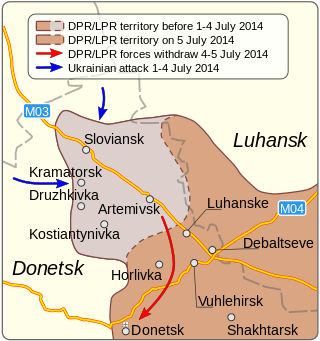
A series of armed skirmishes and confrontations between the Armed Forces of Ukraine and pro-Russian separatists affiliated with the Donetsk People's Republic took place from 12 April until 5 July 2014, and is known as the Battle of Kramatorsk.

On 27 February 2014, the Crimean Verkhovna Rada of Ukraine was taken over by unmarked Russian soldiers. It was among the events that triggered the Russo-Ukrainian War and laid the foundation for Crimea's annexation three weeks later. The Prosecutor's Office of Ukraine's Autonomous Republic of Crimea described the incident as a terrorist attack. A few hours into the takeover, Russia replaced the Prime Minister of Crimea, removing Ukrainian politician Anatolii Mohyliov and installing Russian politician Sergey Aksyonov in his stead.

The siege of Southern Naval Base lasted from 3 March 2014 until its definitive capture on 27 March 2014. The action began with the blockade of Donuzlav bay by the Russian missile cruiser Moskva. The Russian Navy later scuttled the Russian anti-submarine ship Ochakov and several smaller vessels in the mouth of the bay to prevent Ukrainian ships from sailing to open sea and reaching the Ukrainian fleet in Odesa. As a result, 13 Ukrainian ships were bottled up and eventually captured by Russia in Donuzlav bay. The blockade ended when the Russian Navy seized the last ship under the Ukrainian flag in Crimea, the minesweeper Cherkasy.
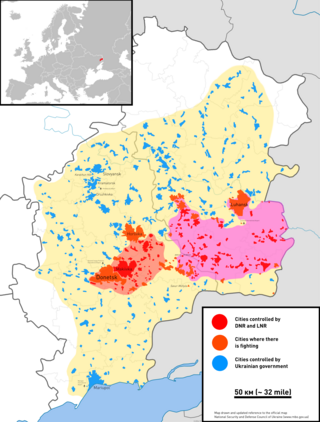
This is a timeline of the war in Donbas for the year 2014.
A military engagement took place between the Armed Forces of Ukraine and the Armed Forces of Russia in the city of Melitopol, Zaporizhzhia Oblast, on the southern front of the Russian invasion of Ukraine. Russian forces entered the city on 25 February and took control of its government buildings.

The battle of Irpin was part of the Kyiv offensive in the Russian invasion of Ukraine for control of the city of Irpin. The combatants were elements of the Russian Armed Forces and Ukrainian Ground Forces. The battle lasted from 27 February 2022 to 28 March 2022 and ended with Ukrainian forces recapturing the city.
The battle of Slavutych was a military engagement which took place during the Russian invasion of Ukraine in the city of Slavutych, a purpose-built settlement for workers in the Chernobyl Exclusion Zone. The city came under attack by Russian forces in March 2022, forcing out Ukrainian defenders.

Saky is an air base adjacent to the settlement of Novofedorivka, Crimea. It was initially built by the Soviet Union in the 1930s, and has been operated under both Ukrainian and Russian sovereignty since 1992.
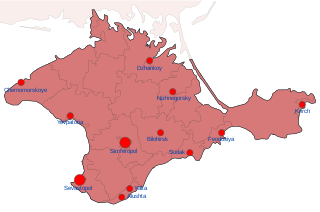
On 27 February 2014, unmarked Russian soldiers were deployed to the Crimean Peninsula in order to wrest control of it from Ukraine, starting the Russo-Ukrainian War. This military occupation, which the Ukrainian government considers to have begun on 20 February, laid the foundation for the Russian annexation of Crimea on 18 March 2014. Under Russia, the Ukrainian Autonomous Republic of Crimea was replaced by the Republic of Crimea, though the legitimacy of the latter is scarcely recognized internationally.
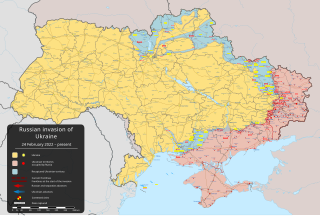
Beginning in July 2022, a series of explosions and fires occurred on the Russian-occupied Crimean Peninsula, from where the Russian Army had launched its offensive on Southern Ukraine during the Russian invasion of Ukraine. Occupied since 2014, Crimea was a base for the subsequent Russian occupation of Kherson Oblast and Russian occupation of Zaporizhzhia Oblast.
The Battle of Artemivsk was a 2014 battle fought in the city of Artemivsk during the war in Donbas in eastern Ukraine as part of the wider Russo-Ukrainian War. It involved armed confrontation between the Special Operations Forces of Ukraine and the National Guard of Ukraine against pro-Russian militias fighting for the Donetsk People’s Republic.

The 204th Sevastopol Brigade of Tactical Aviation named after Oleksandr Pokryshkin is a fighter aviation unit of the Ukrainian Air Force. The brigade is stationed at the Lutsk Air Base.

The 47th Special Purpose Regiment "Tyhr" was a special unit of the Internal Troops of Ukraine that existed from 2004 to 2014 and was stationed in Crimea. The unit performed special tasks for the protection of public order, preservation of the constitutional order, neutralization of subversive groups and counter-terrorism. It was staffed by contractors and conscripts. Its armament is composed of small arms and light artillery. The location of the unit is the village of Krasnokamianka of the Feodosia City Council. One of the battalions was stationed in Sudak. In total, the regiment included three special purpose battalions.

72nd Psychological and Information Warfare Center is a unit of the Ukrainian Special Operations Forces (SOF) concerned with psychological warfare and informational warfare. It was established in 2007 as a part of the Ukrainian Navy and was headquartered at Sevastopol till it was captured by Russia in 2014. It became a part of the SOF in 2016 and is currently headquartered at Kyiv.

Anti-drone meshes refer to metal lattices that surround ground military vehicles to provide additional protection from drone strikes, a practice which became widespread during the Russian invasion of Ukraine. Such protection uses a spaced armour approach, and is designed to prevent the premature detonation or malfunction of the munition.
